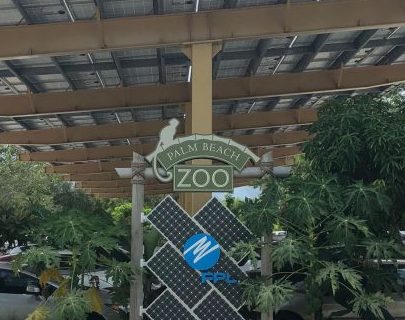May 14, 2020
FPL SolarNow and the Palm Beach Zoo Preserve Swallow-Tailed Kites

The Palm Beach Zoo & Conservation Society in West Palm Beach is home to more than 550 animals across a sprawling 23 acres of land, but did you know that the Zoo does much more than just care for the animals within its walls?
The zoo was one of the first locations to welcome an FPL SolarNow canopy onto its grounds and also has a substantial conservation operation that protects natural wildlife in Palm Beach County, including swallow-tailed kites that spend the summer season here in South Florida.
Read on to learn how FPL is aiding in this effort through the use of solar energy.
Swallow-Tailed Kites
The swallow-tailed kite is a bird in the same family as North American Hawks and Eagles and its habitat extends from the southeastern United States (in the summer) to South America (in the winter). Swallow-tailed kites are an “umbrella” species, which means protecting the kites also protects mature forests and the animals who live there because they are crucial to the entire eco-system.
Kites nest in very tall trees and humid forests where their prey of large insects and small reptiles reside, making Palm Beach County the perfect spot for their summer home.
There, the kites nest, raise their babies and gather in communal roosts to find security from predators and prepare for their 5,000-mile journey back to South America for the winter.
Conservation with FPL

The swallow-tailed kite population is shrinking but efforts to conserve this vital animal are already underway. Palm Beach Zoo works with the Avian Research and Conservation Institute and the Department of Environmental Resource Management to count, track and study these birds and understand how their populations are faring.
This process includes telemetry tracking, which means placing tiny backpacks on the birds to track their movement to and from South America each year. This delicate process is handled expertly by the zoo and its conservation partners to ensure the safety of the swallow-tailed kites.
These telemetry trackers are powered by solar energy and this year, in light of COVID-19 limiting the zoo’s funding, FPL provided the zoo with three additional trackers that will be crucial in obtaining necessary research.
Check out what else solar energy can do!
Solar energy’s opportunities and applications are practically limitless. You can see the power of solar energy up close in community spaces across the state thanks to FPL’s SolarNow program, which places solar arrays at camping sites, museums, parks, and other public places across FPL’s service territory in all corners of the state.


